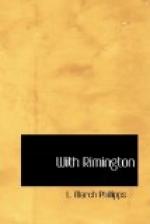The Diamond Hill action was one of those great big affairs which it would be impossible to explain without a plan of the country and a lot of little flags. Our attack from extreme left to right was spread over a frontage of, I daresay, twenty miles. The idea was for the mounted troops to turn the enemy’s flanks and let in the infantry in front. Ian Hamilton had to deal with the Boer left flank, French with the right. Of course we saw and heard nothing of French, who might as well have been fighting in another planet, so far as we knew. Our difficulty here, as on some former occasions, was to find the limit of their flanks. The more we stretch out, the more they stretch out. They have the advantage of being all mounted, while the bulk of our force is infantry, massed inertly in the middle; and also from the lofty position they occupy they can command a bird’s-eye view of the wide valley across which we are advancing, and perceive the disposition of our forces, and in what strength we are threatening the various points of defence, while their forces are quite concealed from us. This is so much in their favour that, on our flank at least, it is we, and not they, who are threatened with being outflanked.
Their position could scarcely have been stronger if nature had designed it for the purpose. A low range of hills gives admittance on the west side to a long wide valley, and on the east side of this a steep rocky range rises boldly up, showing in the sky a level outline like a rampart fringed with wall-like slabs of rock or detached masses, giving excellent cover from shrapnel. But besides this higher and last line of defence, there are some lower hills and slopes which project from the main rampart and command the valley, while they are in turn commanded by the heights. It is a two-step position, in fact. You carry the lower step first, and immediately come under the fire of the upper. The General told me next day that he thought it as strong as anything he had seen on the Natal side, and Winston Churchill set the matter at rest by pronouncing it stronger in point of formation than Spion Kop.
In the first day’s fighting we drove them from the western hills and across the valley, which was more fertile than usual and full of cover, until we had forced them into the two-step eastern range. My own work lay right out on the flank end, at the very finger-tips, where the farthest limit of each force was trying to feel a way round the other. Here, with some of the Camerons, we felt about the hills, shelling them with a couple of guns for Boer sharpshooters, and occasionally flushing one or two. We were rather detached and out of the main action, feeling rather like a gun that has been sent to stop birds from “going back” while the main battue is at work in front. We stayed out all day, and as we rode in that night to headquarters the whole valley under the starlight was echoing like a great gallery and bustling with the multitude of




